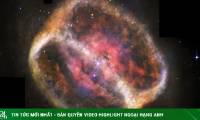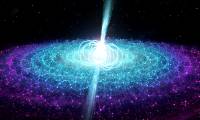
The North Star is famous for being fixed in the northern sky. But it actually moves. Here's what you need to know about the movement of the North Star.

Ancient spiral galaxy discovered, dubbed the monster of the universeA giant barred spiral galaxy estimated to be 11.1 billion years old has been discovered.

For centuries, scientists have wondered why Mars is red.

On Earth, we occasionally witness stunning auroras caused by solar activity – the most famous being the Northern Lights.

Black holes are the hungry monsters of space: super-dense objects that suck in anything that gets too close and tear it apart.

A new image from the world's most expensive space telescope, the James Webb Space Telescope, reveals a stunning and majestic sight: the NGC 1514 nebula – 1,500 light-years from

Astronomers have discovered a collection of small galaxies located about 3 million light-years away, including the smallest and faintest galaxy ever seen.

Several times a year, the deep night sky above us puts on a spectacular show of lights streaking through the darkness.

Engineers have had to come up with some unique ways to create oxygen in the vacuum of space. Here's how astronauts breathe in space.

Everyone knows there is water in the universe, but you might be surprised to learn that it appeared much earlier than expected, especially near the Big Bang.

The universe is a strange place: only 5% of the mass of everything that exists is ordinary matter. The rest is 25% dark matter and 70% dark energy.

Instruments like the James Webb Space Telescope (JWST) are allowing scientists to look further back into cosmic history than ever before, exploring extremely distant objects like

About 600 million years ago, Earth was home to strange, soft-bodied sea creatures. However, a massive asteroid impact in what is now northern Australia may have wiped out this

NASA's Transiting Exoplanet Hunter (TESS) telescope has discovered the largest 'super-Earth' ever seen, 200 light-years away, dubbed TOI-1075b.

One of the common misconceptions about black holes is that they not only swallow matter, but also the history of that matter. The truth about the history of black holes in the

A new impressive image sent back from the world's most expensive space telescope, the James Webb Space Telescope, has captured a rare object called an Einstein ring.

What happens to the human body after spending nearly nine months in space? It turns out the effects are surprising, and you don't have to be a scientist to appreciate them.

This event is extremely rare, but the team hopes to observe more in the future thanks to JWST and other advanced observatories coming online.

The James Webb Space Telescope has just revealed the secret of the dead star that created the crystal nebula 'hourglass'.

The object SGR 0501+4516 is so strange that scientists believe it may hold the secret to the phenomenon of radio bursts.
 The North Star is famous for being fixed in the northern sky. But it actually moves. Here's what you need to know about the movement of the North Star.
The North Star is famous for being fixed in the northern sky. But it actually moves. Here's what you need to know about the movement of the North Star. Ancient spiral galaxy discovered, dubbed the monster of the universeA giant barred spiral galaxy estimated to be 11.1 billion years old has been discovered.
Ancient spiral galaxy discovered, dubbed the monster of the universeA giant barred spiral galaxy estimated to be 11.1 billion years old has been discovered. For centuries, scientists have wondered why Mars is red.
For centuries, scientists have wondered why Mars is red. On Earth, we occasionally witness stunning auroras caused by solar activity – the most famous being the Northern Lights.
On Earth, we occasionally witness stunning auroras caused by solar activity – the most famous being the Northern Lights. Black holes are the hungry monsters of space: super-dense objects that suck in anything that gets too close and tear it apart.
Black holes are the hungry monsters of space: super-dense objects that suck in anything that gets too close and tear it apart. A new image from the world's most expensive space telescope, the James Webb Space Telescope, reveals a stunning and majestic sight: the NGC 1514 nebula – 1,500 light-years from
A new image from the world's most expensive space telescope, the James Webb Space Telescope, reveals a stunning and majestic sight: the NGC 1514 nebula – 1,500 light-years from Astronomers have discovered a collection of small galaxies located about 3 million light-years away, including the smallest and faintest galaxy ever seen.
Astronomers have discovered a collection of small galaxies located about 3 million light-years away, including the smallest and faintest galaxy ever seen. Several times a year, the deep night sky above us puts on a spectacular show of lights streaking through the darkness.
Several times a year, the deep night sky above us puts on a spectacular show of lights streaking through the darkness. Engineers have had to come up with some unique ways to create oxygen in the vacuum of space. Here's how astronauts breathe in space.
Engineers have had to come up with some unique ways to create oxygen in the vacuum of space. Here's how astronauts breathe in space. Everyone knows there is water in the universe, but you might be surprised to learn that it appeared much earlier than expected, especially near the Big Bang.
Everyone knows there is water in the universe, but you might be surprised to learn that it appeared much earlier than expected, especially near the Big Bang. The universe is a strange place: only 5% of the mass of everything that exists is ordinary matter. The rest is 25% dark matter and 70% dark energy.
The universe is a strange place: only 5% of the mass of everything that exists is ordinary matter. The rest is 25% dark matter and 70% dark energy. Instruments like the James Webb Space Telescope (JWST) are allowing scientists to look further back into cosmic history than ever before, exploring extremely distant objects like
Instruments like the James Webb Space Telescope (JWST) are allowing scientists to look further back into cosmic history than ever before, exploring extremely distant objects like About 600 million years ago, Earth was home to strange, soft-bodied sea creatures. However, a massive asteroid impact in what is now northern Australia may have wiped out this
About 600 million years ago, Earth was home to strange, soft-bodied sea creatures. However, a massive asteroid impact in what is now northern Australia may have wiped out this NASA's Transiting Exoplanet Hunter (TESS) telescope has discovered the largest 'super-Earth' ever seen, 200 light-years away, dubbed TOI-1075b.
NASA's Transiting Exoplanet Hunter (TESS) telescope has discovered the largest 'super-Earth' ever seen, 200 light-years away, dubbed TOI-1075b. One of the common misconceptions about black holes is that they not only swallow matter, but also the history of that matter. The truth about the history of black holes in the
One of the common misconceptions about black holes is that they not only swallow matter, but also the history of that matter. The truth about the history of black holes in the A new impressive image sent back from the world's most expensive space telescope, the James Webb Space Telescope, has captured a rare object called an Einstein ring.
A new impressive image sent back from the world's most expensive space telescope, the James Webb Space Telescope, has captured a rare object called an Einstein ring. What happens to the human body after spending nearly nine months in space? It turns out the effects are surprising, and you don't have to be a scientist to appreciate them.
What happens to the human body after spending nearly nine months in space? It turns out the effects are surprising, and you don't have to be a scientist to appreciate them. This event is extremely rare, but the team hopes to observe more in the future thanks to JWST and other advanced observatories coming online.
This event is extremely rare, but the team hopes to observe more in the future thanks to JWST and other advanced observatories coming online. The James Webb Space Telescope has just revealed the secret of the dead star that created the crystal nebula 'hourglass'.
The James Webb Space Telescope has just revealed the secret of the dead star that created the crystal nebula 'hourglass'. The object SGR 0501+4516 is so strange that scientists believe it may hold the secret to the phenomenon of radio bursts.
The object SGR 0501+4516 is so strange that scientists believe it may hold the secret to the phenomenon of radio bursts.























